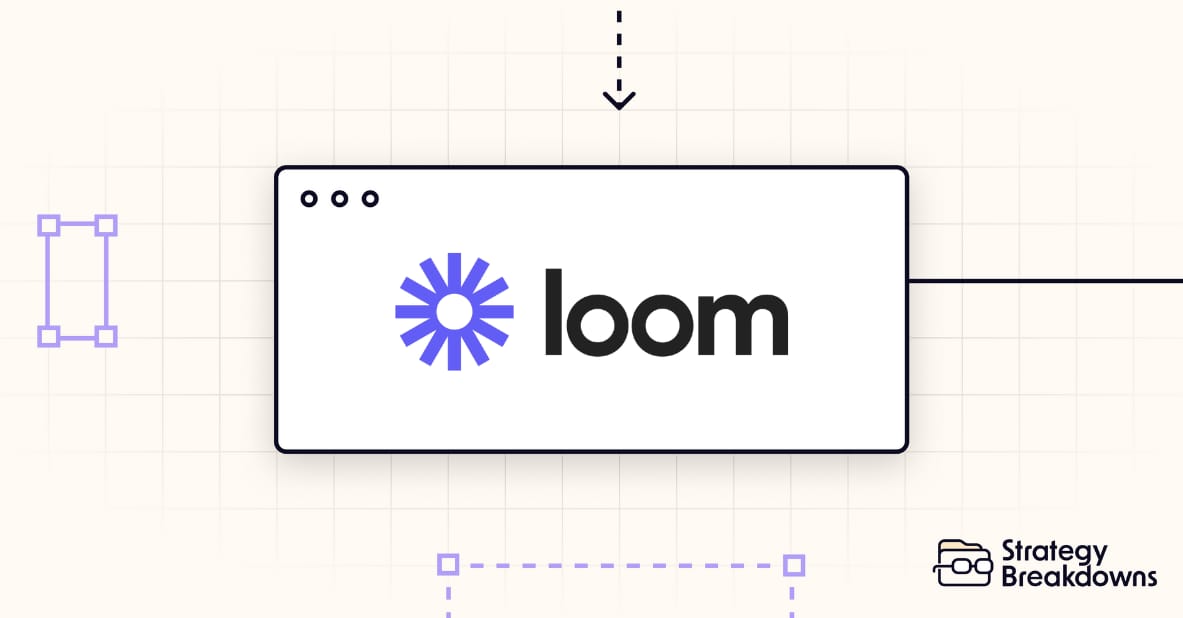Read time: 2 minutes 47 seconds

Welcome to the 4,886 strategy nerds who have joined us over the last 2 weeks!
Join the growing community of 30,760 readers getting byte-sized strategy playbooks here:
3 quick callouts on today’s edition:
Atlassian recently acquired Loom. This breakdown was drafted before the acquisition. Timing is a funny thing.
I’m actually an Atlassian employee. These are my own views, not my employer’s.
I had no idea the acquisition was coming. These things are normally kept pretty quiet internally.
With that out of the way - let’s get into it!


Become Leadership Material in 90 Days
Turn strategy skills into your career superpower with bite-sized, practical tutorials.
No theory, just actionable skills that instantly increase your workplace value.
“We need a front-end developer by Tuesday, but it’ll take months to find someone in the US”
We use Athyna at Strategy Breakdowns – and a bunch of our friends do too. If you are looking for your next remote hire, Athyna has you covered. From sales to marketing, ops to engineering.
The secret weapon for ambitious startups. No search fees. No activation fees. Just incredible talent, matched with AI-precision, at lightning speed.
Thank you for supporting our sponsors, who keep this newsletter free.



Chess Move
The what: A TLDR explanation of the strategy
The most common use cases for screen recording software in 2016:
Recording yourself gaming to create YouTube montages
Demoing a feature of your SaaS tool for your update blog
Creating a tutorial on ‘How to get Adobe Photoshop for free’
…
Recording yourself explaining an idea/question/update to send to a colleague so you can both avoid a meeting.
An irrelevant use case, or an overlooked b2b SaaS opportunity?

💡
Strategy Playbook: Give businesses a tool that is highly shareable, and tangibly saves employees time


Breakdown
The how: The strategic playbook boiled down to 3x key takeaways
1. Build something everyone needs
There aren’t many software categories that 100% of employees in an organisation need a paid license for:
Word processing, task management, instant messaging, and a couple of others.
Historically, screen recording SaaS tools were pitched to specific personas like marketers and designers for publishing demos.
A 1,000 employee company might buy 5 licenses.
Loom promised businesses a new way for all employees to communicate, and save time by doing so.
“Video messaging” saves everyone a meeting, can be watched at 2x speed, and lets recipients jump around to focus on relevant topics.
The same 1,000 employee company can’t wait to buy 1,000 licenses.
2. Make it remarkably frictionless
Imagine you’re an employee wanting to share a screen recording to a colleague.
The old way:
Download a screen recorder
Install the screen recorder locally
Guess the correct video dimensions
Accidentally record without any audio
Wait 10 minutes for the mp4 file to render
Figure out how to add webcam and voiceover
Write an email to explain the recording’s context
Attach the file (before realising it’s too large for email)
Colleague downloads the file, watches on VLC, and emails a reply
The new way:
Loom extension
One-click to record
Video renders instantly
One-click copy a share link
Colleague replies within Loom
Loom took every single step in the workflow and made it frictionless.
They made sending screen recordings to a colleague so easy, the videos became communication tools themselves.
3. Leverage local network effects
When users send a Loom to those not signed up yet, the receiver can still view the Loom and send a reply.
In other words, even non-users experience fast time-to-value.
The modal at the end of a Loom (a) reinforces the value by referencing the time saved, and (b) prompts the receiver to sign up.

Because Looms are inherently shareable within an organisation, employees become net promoters of the tool just by using it.
Similar to the “invite a friend” mechanic that built many of today’s tech giants, employees without a license end up signing up for one organically.
Even with only a handful of initial signups, over time, companies end up becoming a company that uses Loom.


Rabbit Hole
The where: 3x high-signal resources to learn more
[50 minute watch]
Hidden gem: a masterclass on product-led-growth, run by Founder / CEO Joe Thomas.
He breaks down each iteration of the flywheel Loom built to grow to 10 million users without paid marketing.
[14 minute read]
When Loom first launched, it was called “OpenTest” - originally pitched at the ‘usability testing’ use case.
An interesting comment thread: someone asks “What do you think will draw people to Opentest over others in the space?”
Co-founder Joe Thomas elaborates on their strategy at the time: build a ‘two-sided marketplace’ for developers and product experts.
Turns out, they ended up pivoting away from this idea to create Loom, the communication tool, that we know today.
[1 minute read]
Every SaaS company is thinking about AI right now, but many features lack differentiated value.
Loom’s approach: Stay true to their core thesis, and do anything possible to make ‘video messaging’ between colleagues easier.
E.g. AI-powered summaries, action items, timestamps, automatic video titles.
That’s all for today’s issue, folks!
If you’ve got ideas to improve the newsletter, we’d love to hear them! Let us know by replying directly to this email (plus it helps our deliverability!)
Don’t forget to follow along on Twitter [@tomaldertweets] and LinkedIn [/in/tom-alder]


Whenever you're ready, there are 3 ways we can help you:
Our flagship course on how to use free internet data to make better strategic decisions. Contains 5 years of strategy expertise, proven methods, and actionable tactics to accelerate your career with modern-day strategy skills.
We have a growing audience of 55,000+ strategists from top companies like Google, Meta, Atlassian, Stripe, and Netflix. Apply to feature your business in front of Strategy Breakdowns readers.
One of the most common questions we get asked is: “What tools do you use to run Strategy Breakdowns?” So, we’ve open-sourced our tech stack to give you an inside-look at exactly what tools we’re using to power each corner of this operation.






